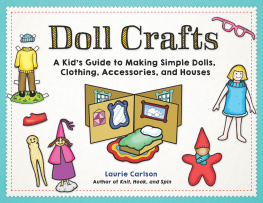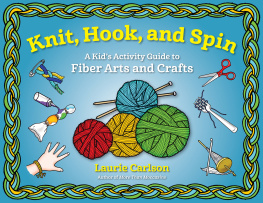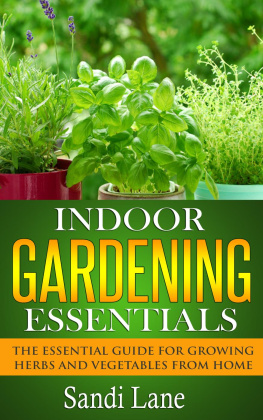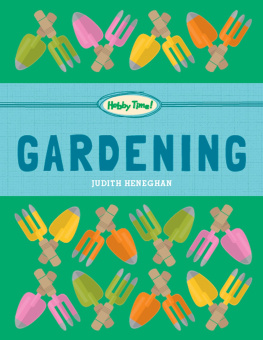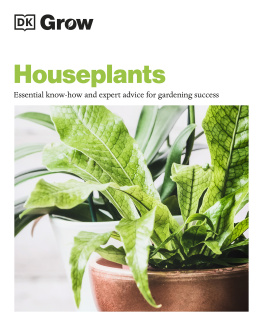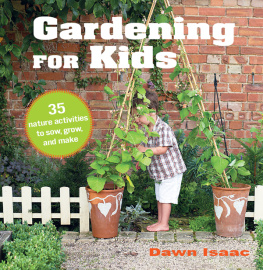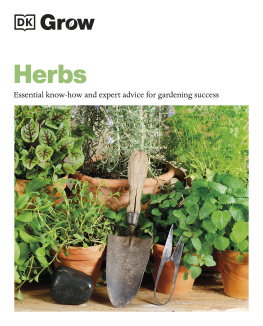GREEN
THUMBS
GREEN
THUMBS

A Kids Activity Guide to Indoor
and Outdoor Gardening
LAURIE CARLSON

Library of Congress Cataloging-in-Publication Data
Carlson, Laurie M., 1952
Green thumbs : a kids activity guide to indoor and outdoor
gardening / Laurie Carlson 1st ed.
p. cm.
Includes bibliographical references and index.
ISBN 1-55652-238-X
1. GardeningJuvenile literature. 2. Nature craftJuvenile
literature. 3. HandicraftJuvenile literature. 4. CookeryJuvenile
literature. [1. Gardening. 2. Nature craft. 3. Handicraft. 4. Cookery.]
I. Title.
SB457.C27 1995
635dc20 94-41895
CIP
AC
The author and the publisher disclaim all liability incurred in connection with the use of the information contained in this book.
Interior illustrations by Sean ONeill
Typography by MobiGraphics, Inc., Chicago, Illinois
1995 by Laurie Carlson
All rights reserved
First edition
Published by Chicago Review Press, Incorporated
814 North Franklin Street
Chicago, Illinois 60610
ISBN-13: 978-1-55652-238-3
ISBN-10:1-55652-238-X
Printed in the United States of America
10 9 8 7 6 5

We can never have enough of nature.
Thoreau

For my husband, Terry
Contents
INTRODUCTION
Welcome to the wonderful world of gardening! With a few seeds, some water, and soil, youll be growing plants of your own in no time. As you enjoy the beauty of watching your plants grow a leaf at a time, you will learn about nature, about where living things come from. Gardening is a hobby that everyone in your family can take part in, and once you learn how to make things grow, its an activity you can have fun with for the rest of your life.
An outdoor garden is a great way to get exercise and fresh air. You can be in the fresh air and imagine what its like to live on a farm. This doesnt mean that you have to have a backyard to be a full-fledged gardener. If you have a windowsill with plenty of sunlight, you have most of what you need to start planting.
When you are the gardener, you can choose what you want to grow. Try growing some healthy food. No tomato from the grocery store is as tasty as the one that grew right before your eyes! Or you might want to plant flowers. Its fun to watch a little green sprout blossom into a colorful flower. Youre the one who decidesyou can do both.
Whether your garden is in a plot in the yard or a pot by a window, whether its a bean plant or an African violetyoull learn about how plants live and grow, and youll enjoy some good things to eat and pretty flowers to gaze at.
By planting a garden, youll discover many exciting things about nature right away: how the weather, temperature, and seasons affect all living things; how living things come out of seeds and soil; how the birds, earthworms, bees, and toads help in the garden; how our whole environment works together like an amazing puzzle.
So get up and get ready to plant. As budding gardeners, were going to get in touch with the world we live in!

PLANTING BASICS
Plants need soil, water, sun, and air in order to live and grow. Minerals in the soil dissolve in water, and the plant roots suck them in; this is the plants food. The water travels up the plant stem and out to the leaves. In the leaves, the plant mixes this food with carbon dioxide. Carbon dioxide is in the air.
The plant leaves use the minerals and water from the soil and carbon dioxide from the air to grow. A special substance called chlorophyll (klor-oh-fill) is in the leaves. Chlorophyll and sunlight together make it all happen.
Its truly amazing what plants can do! The best part is that while the plant does all this mixing and growing, it gives off oxygen from its green leaves. Oxygen is what people and animals breathe, and its very important for them to survive. You can see why we depend on plants!
Plants grow from seedseven towering trees started from seeds. Each seed contains the beginning of a new plant and enough food to start its life. As the plant inside the seed grows, it pushes its way out of the seed. It needs air and water in order to do this.
As soon as the tiny plant gets roots, it needs more food than was stored inside the seed. Now it is ready to take food from the soil. It does this through tiny hairs that grow on the roots. The food in the soil dissolves in water and passes into the root hairs. From there, it moves from the roots up into the stem and out to all the parts of the plant.
How Plants Drink
Want to see how a plant sucks up water? This activity will show you.
MATERIALS
Celery or a white flower
Glass of water
Food coloring
Put several drops of red or blue food coloring in a glass of water. Put a piece of celery in the colored water. Within hours you can see the color begin to travel up the celery stem. The plant is pulling the water up to get it to the leaves. Try putting a white flower, such as a carnation, in colored water. Within a day, the color will have tinted the blossom.
Water for fields of broccoli in California travels in pipes from mountain lakesup to 1,300 miles away!

Tint the water dark red and the celery will turn red, too! You can see how plants move water up to the leaves.

Food coloring in water will tint white carnations. The tips of the petals will change color first.
Tool Time
Youll need some tools to work the soil, of course. You can save old forks, spoons, and kitchen scoops. Use a turkey baster to water hanging plants or delicate seedlings. Scissors are useful when you are taking cuttings or clipping away seedlings to thin a row. Look around and you may find lots of discarded items that can be useful in the garden. There are many tools and pieces of gardening equipment that you can make for yourself, too.

gloves

plant labels

water dropper

trowel

Next page

